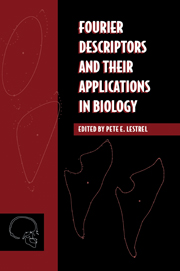Book contents
- Frontmatter
- Contents
- List of contributors
- Preface
- Acknowledgments
- Part one Theoretical considerations
- Part two Applications of Fourier descriptors
- 6 Closed-form Fourier analysis: A procedure for extraction of ecological information about foraminiferal test morphology
- 7 Fourier descriptors and shape differences: Studies on the upper vertebral column of the mouse
- 8 Application of the Fourier method on genetic studies of dentofacial morphology
- 9 Fourier analysis of size and shape changes in the Japanese skull
- 10 Craniofacial variability in the hominoidea
- 11 Heuristic adequacy of Fourier descriptors: Methodologic aspects and applications in Morphological
- 12 Analyzing human gait with Fourier descriptors
- 13 Elliptic Fourier descriptors of cell and nuclear shapes
- 14 Cranial base changes in shunt-treated hydrocephalics: Fourier descriptors
- 15 A numerical and visual approach for measuring the effects of functional appliance therapy: Fourier descriptors
- 16 Size and shape of the rabbit orbit: 3-D Fourier descriptors
- 17 From optical to computational Fourier transforms: The natural history of an investigation of the cancellous structure of bone
- 18 Epilogue: Fourier methods and shape analysis
- Appendix
- Glossary
- Index
7 - Fourier descriptors and shape differences: Studies on the upper vertebral column of the mouse
Published online by Cambridge University Press: 14 September 2009
- Frontmatter
- Contents
- List of contributors
- Preface
- Acknowledgments
- Part one Theoretical considerations
- Part two Applications of Fourier descriptors
- 6 Closed-form Fourier analysis: A procedure for extraction of ecological information about foraminiferal test morphology
- 7 Fourier descriptors and shape differences: Studies on the upper vertebral column of the mouse
- 8 Application of the Fourier method on genetic studies of dentofacial morphology
- 9 Fourier analysis of size and shape changes in the Japanese skull
- 10 Craniofacial variability in the hominoidea
- 11 Heuristic adequacy of Fourier descriptors: Methodologic aspects and applications in Morphological
- 12 Analyzing human gait with Fourier descriptors
- 13 Elliptic Fourier descriptors of cell and nuclear shapes
- 14 Cranial base changes in shunt-treated hydrocephalics: Fourier descriptors
- 15 A numerical and visual approach for measuring the effects of functional appliance therapy: Fourier descriptors
- 16 Size and shape of the rabbit orbit: 3-D Fourier descriptors
- 17 From optical to computational Fourier transforms: The natural history of an investigation of the cancellous structure of bone
- 18 Epilogue: Fourier methods and shape analysis
- Appendix
- Glossary
- Index
Summary
The measurement of biological shape change
Biologists are interested in living things. Morphologists are interested in the shape of living things, the differences in shape between living things, and the transformation of one shape into another.
In recent years there have been a number of developments in techniques for shape description in areas outside the biological sciences, stimulated, in part, by developments in image processing technology. It is now a relatively simple and inexpensive task to extract and store a closely placed series of Cartesian coordinates taken from the outline of a structure using an inexpensive video-digitizer. This newly available technology has led biologists to try various new means for form description which will allow more information derived from the outline data to be compared or studied than permitted by previous methodology (O'Higgins and Johnson, 1988).
Before one can compare forms one must describe them. The descriptions may be purely subjective, in which case the comparisons between forms are also subjective. The trend, however, is toward more objective studies, which implies a quantitative method of form description. There are many ways in which form may be described. Some of these are particularly relevant to biological material, for example, distances between “homologous landmarks”: others, such as measures of perimeter, curvature in outline, and so on, are equally applicable to biological or nonbiological material.
- Type
- Chapter
- Information
- Fourier Descriptors and their Applications in Biology , pp. 157 - 188Publisher: Cambridge University PressPrint publication year: 1997
- 3
- Cited by



